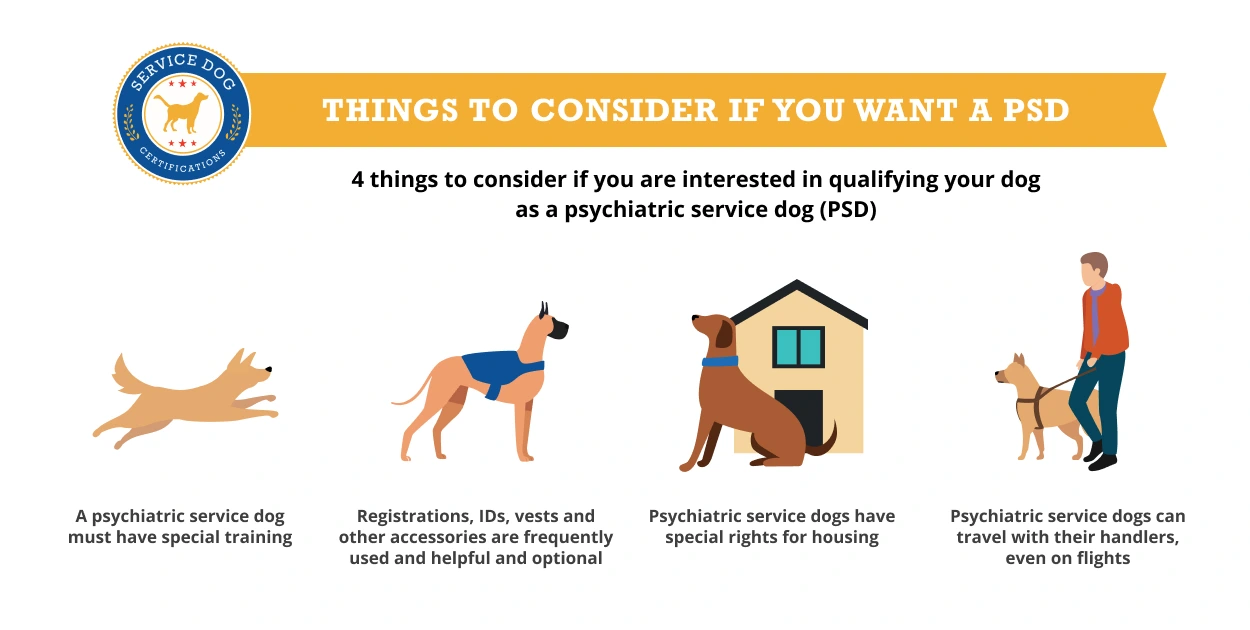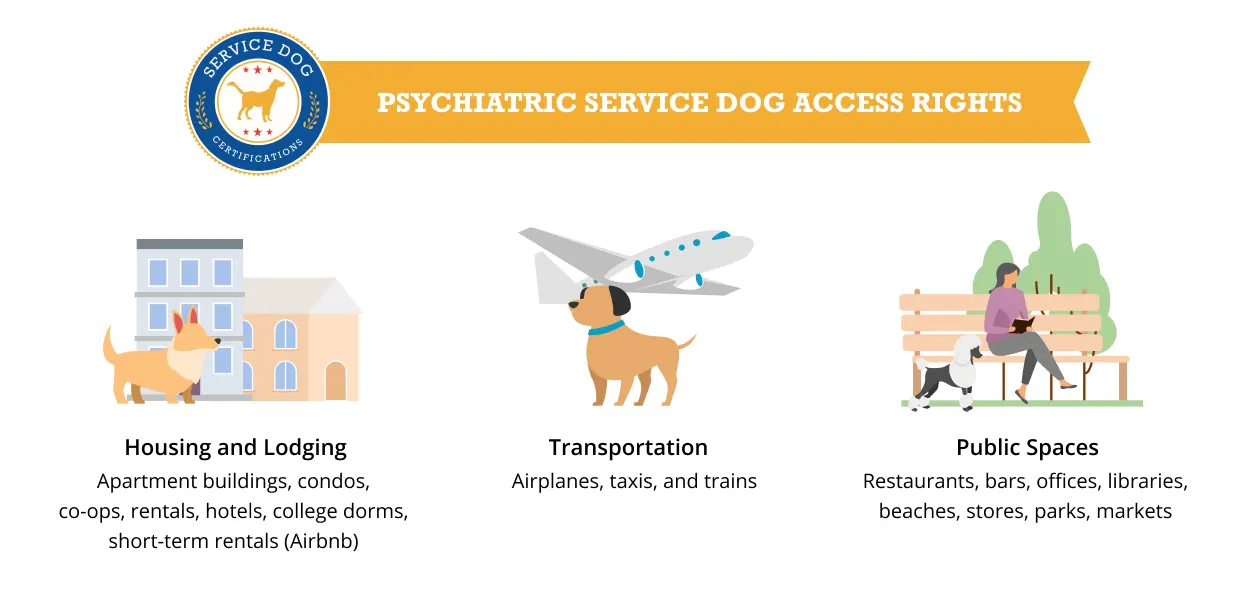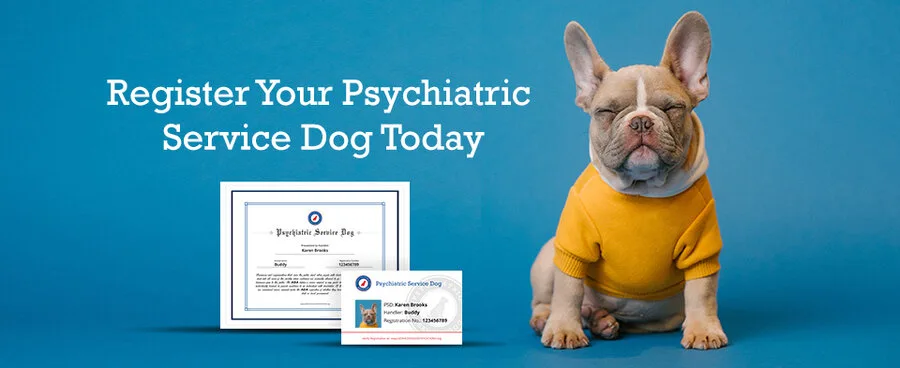Psychiatric Service Dog

Psychiatric service dogs (PSDs) are service dogs that help people with “invisible disabilities,” meaning mental health issues like ADHD, anxiety, and depression, and they have the same rights as traditional service dogs that help people with physical disabilities like vision and mobility impairment. The legal protections that a psychiatric service dog has include:
- Access to public places like stores, restaurants, theaters and hotels
- The ability to fly in the cabin of an airplane and walk through an airport
- Access to buildings that do not allow pets, like offices, train stations, and campuses
- Access to no-pets housing and exemption from pet fees and deposits
- Exemption from residential breed and size restrictions
Psychiatric service dogs are legal service dogs with training to perform tasks related to the handler’s mental health condition. For example, they can remind the handler to take medication, calm the owner with touch during moments of crisis, and interrupt negative behavior patterns. In this comprehensive guide, our service dog experts will teach you everything you need to know about psychiatric service dogs, including how to legally get one.
Table of contents
Qualifications for a Psychiatric Service Dog
To qualify for a psychiatric service dog, you need to meet two service dog requirements: having a qualifying disability and a dog that has been trained to perform a task relating to your condition. The ADA defines a mental health disability as “any mental or psychological disorder” such as “emotional or mental illness, and specific learning disabilities” that substantially limits one or more major life activities, such as the ability to work, socialize, sleep, or go to school.
The following mental health conditions can qualify for a psychiatric service dog:
- Major depression (Clinical depression)
- Anxiety disorders (i.e., generalized anxiety disorder (GAD), social anxiety, etc.)
- Phobias (i.e., specific or general phobias)
- Post-traumatic stress disorder (PTSD)
- Attention-deficit hyperactivity (ADHD)
- Manic depression (Bipolar disorder)
- Obsessive-compulsive disorder (OCD)
- Autism spectrum disorder (ASD)
If you’re not sure if you have an eligible condition, ask a licensed mental health professional for a PSD letter to document and confirm whether you have an eligible condition. Documentation for service dogs is not required under the ADA. For handlers with invisible disabilities, however, in the form of a psychiatric illness, a PSD letter provides the handler with confidence that they meet service dog disability standards.
In addition to having a psychiatric, intellectual, or other mental health condition, the handler must need a task-trained dog to assist with their condition. The key difference between a psychiatric service dog and a normal dog is that a PSD must be trained to perform work relating to their handler’s disability. In the next section, we will give examples of the tasks that PSDs are entrusted to perform.
If you want to know if you qualify for a Psychiatric Service Dog, apply for your PSD Letter. Through our partner, we can connect you with a licensed healthcare provider so they may assist you.
Get Your PSD Letter NowPsychiatric Service Dog Tasks
Psychiatric service dogs are trained to do work that allows people with psychiatric disabilities to function in everyday life. There is an amazing variety of service dog tasks; here are just a few:
Some common tasks are:
- Retrieve medications (picking up medication from a table or ringing a bell as a reminder)
- Tactile stimulation and deep pressure therapy (DPT) (using touch or gentle pressure to provide calm and comfort to a handler who is in distress)
- Ground and reorient (grounding the handler back into a more present state of mind during an anxiety attack)
- Interrupt and redirect (limiting obsessive-compulsive and self-destructive behaviors by interrupting or redirecting)
- Find a person/place (locating people/places for those with severe anxiety in crowded environments)
- Navigation and buffering (buffering and guiding their handler through stressful environments)
- Room search (performing a room search to help those who suffer from hyper-vigilance caused by PTSD)
- Stabilize routines (helping maintain healthy routines by, for example, preventing them from oversleeping or reminding the handler to do daily tasks)
Overview of Psychiatric Service Dog Access Rights
Psychiatric service dogs have rights under ADA service dog laws that allow them to be in public areas where pets are not allowed. That includes places like parks, beaches, markets, stores, restaurants and theaters. PSD handlers also have the right to live with their dogs in most types of housing under the Fair Housing Act. That includes apartment buildings, condos, co-ops, rentals, hotels, college dorms, and short-term rentals (Airbnb).
Owners of PSDs do not have to pay fees or deposits to their landlord or housing association in order to have a PSD in their residence. Even if the building strictly bans all dogs, psychiatric service dogs must still be allowed. In addition, PSDs are allowed to fly in the cabin with their owners, free of charge, under the U.S. Department of Transportation’s rules. In order to fly with a PSD, owners must submit the DOT’s Service Animal Air Transportation Form to their airline in advance.
Service dog owners also have these rights:
- Cannot be isolated from other patrons by a business
- Cannot be treated less favorably than other customers
- Cannot be charged fees that are not charged to other customers without animals.
- Cannot be charged a deposit or fee that would be paid by customers with normal pets.
Note that even with these access rights, a handler can still be asked to remove his psychiatric service dog from an establishment if (1) the PSD is out of control and the handler doesn’t take effective action to control it or (2) the PSD is not housebroken. Even when a PSD is properly asked to leave a site, the handler must still be offered the opportunity to obtain goods or services with the animal removed.
Share this image on your site
No matter where you take your PSD, keep in mind that if your PSD misbehaves, it can be asked to leave. Service animals can be denied entry if they are acting aggressively, barking or growling repeatedly, or causing unsanitary conditions. A psychiatric service dog must always be under the handler’s control when out in public.
Emotional Support Animals versus Psychiatric Service Dogs
Psychiatric service dogs are similar to emotional support animals (ESAs) but with one significant difference: Unlike ESAs, PSDs undergo specialized training to help people with mental illnesses and learning disabilities. A service dog, by definition, must be able to perform a task or job related to the handler’s health condition.
By contrast, emotional support animals do not need any special training. They make people with depression, anxiety, PTSD, and other mental illnesses feel better just through their companionship. To qualify for an emotional support animal, you need an ESA letter from a therapist.
Another major difference has to do with access rights. Emotional support animals only have housing rights under the Fair Housing Act, which means they can live in no-pet buildings, free of charge. Service dogs also have housing rights, but in addition to general public access and air travel rights under the ADA and Air Carrier Access Act, which is something ESAs don’t have.
ADA Verification of a Psychiatric Service Dog
Under the Americans with Disabilities Act, if you’re out in public or at an establishment and someone wants to verify your psychiatric service dog, they are allowed to ask two questions:
- Is the dog a psychiatric service dog required because of a disability?
- What work or task has the PSD been trained to perform?
No matter what task your PSD is trained to perform, you have a right to privacy and dignity when it comes to your condition and needs for a service animal. Under the ADA, staff members at an establishment are prohibited from asking you to demonstrate the tasks your PSD has been trained to perform.

Training a Psychiatric Service Dog
Service dog laws permit owners to self-train their psychiatric service dogs. Self-training has a lot of benefits if you’re comfortable with dog training basics and enjoy teaching new skills to a dog. If you’re not comfortable training your own dog, you should hire a professional trainer. There is no “official” training program for PSDs, although there are entities that issue guidelines and suggestions.
In addition to being trained to perform the task related to a handler’s disability, a PSD must always be under its owner’s control. Under ADA rules, a PSD must be harnessed, leashed, or tethered at all times unless that would interfere with the PSD’s ability to work (in which case, the handler can use other means of control like voice commands or physical signals). For air travel, a PSD must always be harnessed, leashed, or tethered and not engage in disruptive behavior.
Tracking Training Milestones
There are important milestones a PSD owner should track to determine whether their psychiatric service dog is ready to be taken in public:
- Can the PSD ignore distractions?
- Is the PSD obedient even in busy areas?
- Does the PSD run after or lunge at other people and animals?
- Is the PSD calm when around children and other animals?
- Is the PSD able to maintain its focus on the handler even with the presence of food and treats?
- Does the PSD growl or bark uncontrollably?
- Can the PSD remain on task in loud, crowded places?
- Is the PSD calm around moving vehicles and traffic?
These are just some tests your PSD should pass with flying colors before going out in public. A PSD that is unruly can be asked to leave an establishment. Of greater concern, a poorly trained PSD may not be able to perform the critical duties it has been entrusted with if it is not accustomed to a particular environment.
Psychiatric Service Dog Registration
What’s required: If you have a psychiatric service dog, you can voluntarily register your service dog with ServiceDogCertifications.org and obtain service animal paraphernalia. Under ADA rules, registering a service animal does not confer legal rights, but registrations and service animal accessories are routinely used by handlers for their personal convenience. Check out this link for full details on how to register a dog as a psychiatric service dog.
Why do it: As someone with an invisible disability, you may want a method for strangers or workers to immediately understand that your animal companion is not just a pet or an emotional support animal. Not only does this help set proper boundaries, but PSD registration and accessories can also help protect your privacy by reducing the need to answer unwelcome questions. Keep in mind this is completely optional and does not substitute for proper training and professional help in evaluating a psychiatric condition.
What can help: Vests, tags, ID cards, harnesses, and other service animal gear are designed to help you enter public spaces with your PSD with confidence. These items also help ward off annoying and potentially unsafe approaches by strangers and children who may not realize your PSD is a working animal and not a pet. Service Dog Certifications can keep your psychiatric service dog’s information in its registration database and issue an identification ID card, certificate, or vest, depending on your needs.
Register Your PSD HereAbout the Author: The writing team at Service Dog Certifications is made up of folks who really know their stuff when it comes to disability laws and assistance animals. Many of our writers and editors have service dogs themselves and share insights from their own experiences. All of us have a passion for disability rights and animals.
Related Articles

Hipster Dogs: Trendy Pups, Beards, and Beanies
From PBRs to beanie caps, and from plastic sunglasses to “pawsome” music, hipster dogs have taken the world by storm, and there’s no turning back. Because, let’s face it, these little guys and gals were rocking the style before it was cool — not that they would care what’s cool, though. For a “pawsitevly” good […]

Read More

How Dogs Can Calm Anxiety
A person suffering from anxiety attacks experience many risks, and it’s one of the reasons why it’s prudent to consider having a service dog or emotional support animal as a companion. The animal can keep the environment safer for the individual and below are some of the ways a dogs can calm anxiety: 1) Dogs […]

Read More

Can Cats Be Service Animals?
Having a cat brings the same positive effects as dogs. These pets can be equally beneficial to a person’s health. Experts have proven that cat owners are less likely to have a health emergency, such as a heart attack, with their feline companion around and cats have also been proven to help alleviate sleeping disorders, […]

Read More

